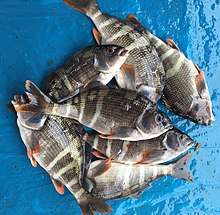Cheilodactylus variegatus
Cheilodactylus variegatus, the Peruvian morwong[2] or bilagai,[3] is a species of ray-finned fish found in the southeastern Pacific Ocean off the western coast of South America. Although traditionally included in the genus Cheilodactylus in family Cheilodactylidae, based on genetic and morphological analyses it belongs in the genus Chirodactylus in family Latridae.[4][5]
| Peruvian morwong | |
|---|---|
 | |
| Freshly caught Peruvian morwong in the port of Ancón, Peru. | |
| Scientific classification | |
| Kingdom: | |
| Phylum: | |
| Class: | |
| Order: | |
| Family: | |
| Genus: | |
| Species: | C. variegatus |
| Binomial name | |
| Cheilodactylus variegatus Valenciennes, 1833[1] | |
| Synonyms[1] | |
| |
Description
C. variegatus can grow to a maximum length of 40 cm (16 in) and a maximum recorded weight of 1 kg (2.2 lb).[2]
Distribution
C. variegatus is endemic to the subtropical southeastern Pacific Ocean, within the area bounded by 5°S to 37°S, and 81°W to 71°W . Its range extends southwards along the coast of South America, from Paita in Peru to Talcahuano in Chile.[2]
Ecology
C. variegatus occurs in small schools amongst the kelp forests of Macrocystis integrifolia which grow on rocks in the shallow subtidal zone and the lower intertidal zone on the coast of Chile.[3]
In a survey of the inhabitants of these kelp forests, there was found to be a wide diversity of molluscs and crustaceans, with the sea urchin Tetrapygus niger and the gastropod Tegula tridentata being dominant. The most common fish was the herbivorous Aplodactylus punctatus. The main carnivorous fish were the Peruvian morwong, the Chilean sandperch (Pinguipes chilensis), the Cape redfish (Sebastes capensis) and the sea chub Graus nigra.[6]
Uses
People of the Chinchorro culture who inhabited the arid coast of Chile some 3500 BP and built their culture around fishing, had sophisticated fishing equipment and their middens show abundant remains of C. variegatus, along with those of the clingfish Sicyases sanguineus, the Chilean sheepshead wrasse Semicossyphus darwini and Labrisomids.[3]
References
- Bailly, Nicolas (2018). "Cheilodactylus variegatus Valenciennes, 1833". WoRMS. World Register of Marine Species. Retrieved 22 July 2018.
- "Cheilodactylus variegatus Valenciennes, 1833". FishBase. Retrieved 22 July 2018.
- Sanz, Nuria; Arriaza, Bernardo T.; Standen, Vivien G. (2015). The Chinchorro culture: a comparative perspective, the archaeology of the earliest human mummification. UNESCO Publishing. p. 25. ISBN 978-92-3-100020-1.
- Ludt, W.B., Burridge, C.P. & Chakrabarty, P. (2019). A taxonomic revision of Cheilodactylidae and Latridae (Centrarchiformes: Cirrhitoidei) using morphological and genomic characters. Zootaxa 585(1). doi:10.11646/zootaxa.4585.1.7
- Eschmeyer, W. N.; R. Fricke & R. van der Laan (eds.). "Chirodactylus species". Catalog of Fishes. California Academy of Sciences. Retrieved 6 July 2019.
- McClanahan, Tim; Branch, George (2008). Food Webs and the Dynamics of Marine Reefs. Oxford University Press, USA. pp. 90–95. ISBN 978-0-19-531995-8.